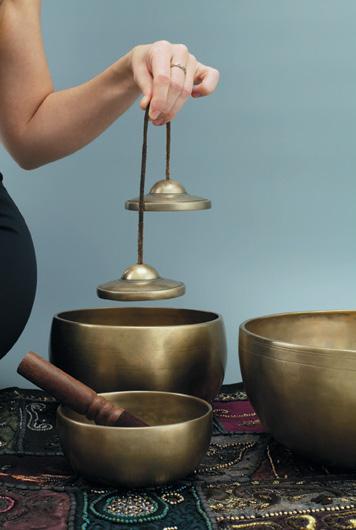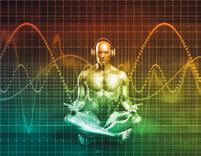
4 minute read
GOOD VIBRATIONS
THE HEALING POWER OF SOUND
by Gayatri Bhaumik
Advertisement

Magic Bowls/Unsplash.com F or centuries, humans have employed sound in an attempt to heal and cure. The ancient Greeks believed in the power of music, using flutes, lyres and zithers to treat illness and vibrations to alleviate mental disorders. Even today, military battalions play music to boost morale. “Research shows that vibrations are the language of the body,” says Kyle Godfrey-Ryan, the founder of TUNE, a New York-based tech system designed to recalibrate the nervous system with sounds. “When we work with sound, we’re working with vibrations that can rebalance the nervous system and flood the body with endorphins.”
According to Susy Markoe Schieffelin, a healing practitioner at The Copper Vessel, in Los Angeles, “Sound vibrations work on a cellular level to recalibrate the body. Sound shifts vibrations in the body, both through entrainment—a process by which the vibrations of one object transform to match the higher vibration of another object—and by stimulating electric signals in the brain that support healing frequencies.”
Studies suggest that sound vibrations can unlock energy blockages, release tension and create calm and focus. For this reason, sound healing is frequently prescribed to manage conditions like anxiety, depression and post-traumatic stress disorder. Some practitioners also report anecdotal metabolic improvements, from lower blood pressure and decreased cholesterol levels to improved sleep.
TUNE has worked with the National Institutes of Health and the Mayo Clinic to gain scientific backing for the brand’ s devices. “Our technology reduces stress by 54 percent in 15 minutes,” Godfrey-Ryan claims. “It also has a massive impact on
the circadian rhythm, so we’re able to prove better sleep quality, improved metabolism and reduced stress and anxiety.”
Sound healing can take many forms, and each type has specific applications. For example, Schieffelin explains, “Gongs and Tibetan bowls are very clearing and grounding, while crystal singing bowls feel more uplifting and elevating.” It is up to the individual to find a style that works for them and their intended results.
Singing Bowls
Originating in12th-century Tibet, these metal bowls come in different sizes, each producing a specific sound vibration that is said to work on a particular part of the brain or body. Several-sized bowls often are used together to create a holistic healing approach. They can be placed directly on parts of the body to stimulate circulation and relax muscles. Singing bowls made of pure crystal quartz are popular for their pure sounds, and are believed to offer stress reduction, chakra balancing and mental clarity.
Gongs
stevica mrdja/EyeEm/AdobeStock.com
Used in healing since about 4,000 B.C., gong baths, which combine different tones and melodies to fashion multifaceted vibrations, may positively influence the mind and body by stimulating the vagus nerve. Godfrey-Ryan advises, “Gongs are amazing for trauma release, but gong work is very heavy, so if you’ve never played with sound before, this will be really intense.”
Vocal Toning
V. Kudryashov/AdobeStock.com
Numerous cultures— from ancient Egyptians to Tibetan throat singers—have their distinct forms of vocal toning. Hindu mantras can be especially powerful for some people because they harness the energy of specific words and intonations. Among practitioners, seven distinct tones have been linked to specific parts of the body. It is believed that these vibrations can balance the body’s cells and open energetic healing, leading to targeted benefits. While musicians use these devices to ensure that their instruments are set to the correct pitch, they also can be held next to specific parts of the body by individuals seeking healing vibrations, emotional balance and pain relief. “Tuning forks are fun because you can have a very strong somatic reaction within a few seconds— they’re very powerful,” notes Godfrey-Ryan.
Microgen/AdobeStock.com

Solfeggio Frequencies
Solfeggio frequencies are musical tunes or sound patterns designed to kentoh/AdobeStock.com stimulate the brain by syncing brain waves to specific healing frequencies. Each of the seven most popular solfeggio frequencies sets out to target a certain purpose, from improving relationships and awakening intuition to navigating change and letting go of fear.

Binaural Beats
Binaural beats are soundscapes that create a gap between different frequencies. For example, the tune might have a tone of 210 Hertz (Hz) in the left ear and 200 Hz in the right ear, producing an illusory tone of 10 Hz, also known as a binaural beat. Brainwaves are thought to automatically align themselves with this auditory tone, which may be useful for improving focus and reducing stress.
Sound healing is finding a permanent place in modern wellness culture as more people experience its rewards. While there are myriad ways to use sound vibrations for healing purposes, it is up to each individual to find the style that resonates with them and achieves the improvements they seek. With regular practice, they may even find relief that is cumulative and long-lasting.
Gayatri Bhaumik is a professional writer and editor. For more information, visit GayatriBhaumik.com.








